

Pottery technique. Art & pottery. Ceramics. Ceramic and chocolate printing. Clay, Pottery Tools, Ceramic Glazes & Equipment. Longquan celadon. Truncated with mountings Longquan Celadon in the Topkapı Palace, Istanbul, Turkey.

Longquan celadon (龍泉青磁) refers to Chinese celadon produced in Longquan (龍泉) kilns which were largely located in Lishui prefecture in southwestern Zhejiang Province. With those in other prefectures the total of discovered kiln sites is over two hundred, making the Longquan celadon production area one of the largest historical ceramic centers in all of China. Overview[edit] A Longquan Ware Celadon Vase, Song Dynasty, 13th Century, from the Nantoyōsō Collection, Japan Celadon production had a long history at Longquan and related sites, but it was not until the Five Dynasties (五代 907–960) and Northern Song (北宋 960–1127) period that production of scale truly began.
Longquan celadons thus were an important part of China's export economy for over five-hundred years. Southern Song celadons display the greatest variety of shape and glaze color. See also[edit] Bibliography[edit] References[edit] External links[edit] Ceramique. Glazes: Representative Works. DFW Pots. Great mid range pottery glazes. The benefits of firing underglazed pottery (mainly children's work) is that the end result is much more durable than low fired projects.

We really wanted the projects to last for generations remembering how our parents and grandparents cherished our school ceramic work. We therefore, fire all of our work and our students work to cone 6 including underglazes. We learned that the majority of underglazes do not yield good and expected results and not all clear glazes interact favorably with underglazes. Most underglazes and most clear glazes will cause blistering, fade or change colors. After numerous tests, we are satisfied with the results and been using those select few colors listed in the table below successfully.
Green Celadon Cone 10 Ceramic Glaze. Green Celadon is a High-Fire Ceramic Glaze Recipe.
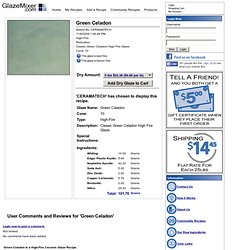
SALE Yunomi Celadon Tea Bowl259 imperfect/2nd by wagnerpottery. Ice Blue Celadon Porcelain Urn by bluemistpottery. Cool pots. Pattern Transfers onto Ceramic Bisque. » How to Carve Low-Relief Surface Designs into Wet Clay. Carving Tools Pottery supply stores sell many types of carving tools you can use to achieve the results you want.
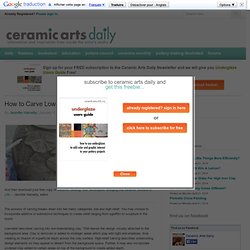
The needle tool is very handy for cutting into tight corners. A variety of different sized loop tools can be used for extracting negative space areas. Beveled edges are easy to carve with the right size ribbon tool. Finally, for undercutting, texture and cleanup, the curved side of a double headed clean up tool works well. Plan Ahead Success depends on the careful planning of your object, a systematic method of extracting the clay, and a slow drying time. Carving Techniques To achieve the look of low relief, draw an outline onto the clay surface. Undercutting techniques create pieces with even higher relief areas. Pottery Tips and Techniques Painting Your Bisque.
Ceramics. Handbuilt Pottery Making Video: How to Make a Properly Functioning Handbuilt Spout for a Teapot. Ceramic Face Wall Sculpture by blmartinstudios. Pottery Berry Bowl with Handle Small in Burlap by FringeandFettle. Mayumi yamashita 'make me me': learning by making. How it's made... how it affects whole design... why is it necessary?

なぜそれが必要なのか? When you know why and how you would realise how deep 'making' could be. Greek & Roman Mythology - Tools. Instructional Aids - Alex Kolbo. Matériel poterie. Céramique Poterie. Workshop Handbook: Clay Projects and Studio Resources. Welcome to your workshop!
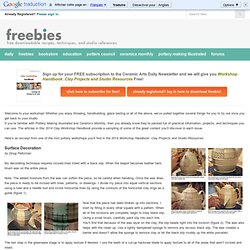
Whether you enjoy throwing, handbuilding, glaze testing or all of the above, we’ve pulled together several things for you to try out once you get back to your studio. If you’re familiar with Pottery Making Illustrated and Ceramics Monthly, then you already know they’re packed full of practical information, projects, and techniques you can use. The articles in this 2014 Clay Workshop Handbook provide a sampling of some of the great content you’ll discover in each issue. ART Sculpture CLAY on Pinterest. Flat to Functional: Handbuilding & Slip Decorating : Ceramic Arts Daily. In this installment of the Ceramic Arts Daily Presents Video Series, potter Lisa Naples shares her love of handbuilding with earthenware.

Determined to change the myth that earthenware is punky and weak, Lisa explains how this beautiful forgiving clay body is every bit as strong as its higher-fired counterparts when it’s fired beyond the traditional Cone 04. In addition to covering the mechanics of good slab rolling, Lisa guides you through her straightforward soft-slab building techniques. She demonstrates how to add interest to handbuilt forms by adding texture and cutting darts to create custom shapes. In the decorating portion of the video, Lisa gives a thorough explanation of her “dry” and “wet” slip brushing techniques, explaining how they can add both beautiful texture and color. Throw, Cut, and Paste: Combining Wheel Throwing, Handbuilding and Multi-Step Glazing to Create Distinctive Vibrant Forms : Ceramic Arts Daily.
The Pedestal Gravity is one of the challenges faced when it comes to thrown forms.
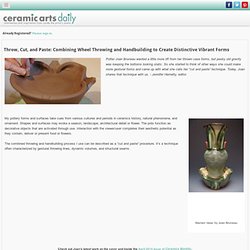
A thrown and altered shape may have a dynamic profile from the waist up while the foot often remains static and gravity bound. This issue can be resolved in a few different ways. fig. 1 (click to enlarge) Starting a piece by throwing it up-side down allows alteration to the foot and the opportunity to create a dynamic negative shape under the base. Fig. 2 To begin the pedestal, throw a tapered cylinder with a ¼-inch thick floor. CERAMIC TUTORIALS. Hazards in Ceramic. Lead poisoning from pottery glaze and paint NO form of lead or arsenic may be used in our materials without specific clearance and training from the instructor.
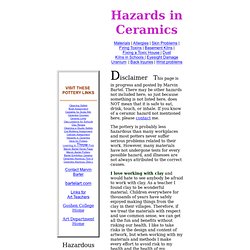
Lead is hazardous to breathe, to ingest (eat), and can be released from firing into the air. Finally, any container glazed with these materials may be toxic to eat or drink from because lead can leach into food or drink stored in the vessel. While new pottery sold today in the United States is generally assumed to be safe from lead, occasionally one still reads about cases of pottery that is accidentally sold with dangerous amounts of lead in the glaze. Lead has many very serious effects if ingested. Lead can be absorbed from glazes by acidic food or drink.
In paint, lead carbonate was formerly used for white. Ceramic ideas for kids. Art Form: Pottery for Kids. 4 Crazy Kings: How To Make a Quick Clay Owl. 10 Wow, what a week this has been.
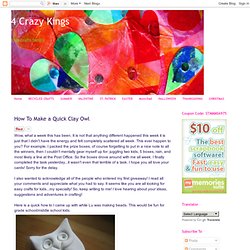
It is not that anything different happened this week it is just that I didn't have the energy and felt completely scattered all week. This ever happen to you? For example, I packed the prize boxes, of course forgetting to put in a nice note to all the winners, then I couldn't mentally gear myself up for: juggling two kids, 5 boxes, rain, and most likely a line at the Post Office. So the boxes drove around with me all week. I finally completed the task yesterday...it wasn't even that terrible of a task. Primitive Technology, Traditional Skills and Hand-Made Tools.
Potterycrafts. Moldmaking and Casting with BITY Mold Supply. How to ceramics. Free Gifts.